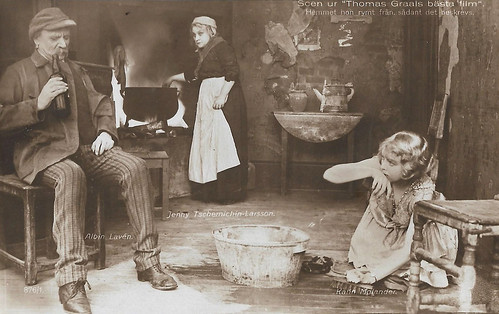
Swedish postcard by Ed. Nordisk Konst, Stockholm, no. 876/1. Photo: Svenska Biografteatern AB. Publicity still for Thomas Graals bästa film/Thomas Graal's Best Film (Mauritz Stiller, 1917). Caption: The home she ran away from, as it was described. Karin Molander as Bessie, with her parents played by Albin Lavén and Jenny Tschernichin-Larsson.

Swedish postcard by Ed. Nordisk Konst, Stockholm, no. 876/2. Photo: Svenska Biografteatern AB. Victor Sjöström, Karin Molander and Gucken Cederborg in Thomas Graals bästa film/Thomas Graal's Best Film (Mauritz Stiller, 1917). Caption: Writer Thomas Graal has been shopping.
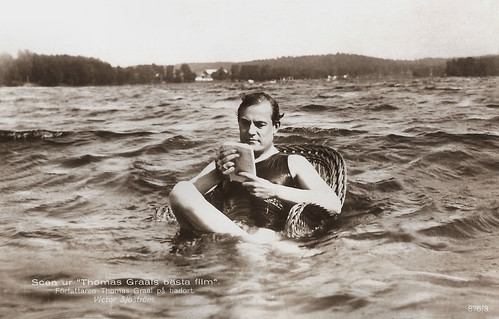
Swedish postcard by Ed. Nordisk Konst, Stockholm, no. 876/3. Photo: Svenska Biografteatern AB. Publicity still for Thomas Graals bästa film/Thomas Graal's Best Film (Mauritz Stiller, 1917) with Victor Sjöström. Caption: The author Thomas Graal at sea.
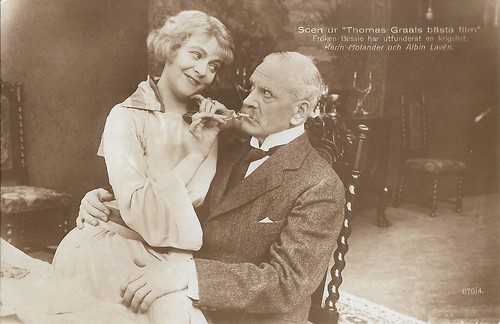
Swedish postcard by Ed. Nordisk Konst, Stockholm, no. 876/4. Photo: Svenska Biografteatern AB. Publicity still for Thomas Graals bästa film/Thomas Graal's Best Film (Mauritz Stiller, 1917), with Karin Molander as Bessie and Albin Lavén, who plays her father. Caption: Miss Bessie has invented a war stratagem.
An adorable romantic comedy, a social tract and one of the first films about filmmaking
In Thomas Graals bästa film/Thomas Graal's Best Film (Mauritz Stiller, 1917), the great Victor Sjöstrom stars as Thomas Graal, a screenwriter. He is very fond of his secretary Bessie, played by the lovely Karin Molander. However, she runs away from his kisses and embraces. In fact, Bessie has already run away earlier from her proper and domineering mother and her bumbling father to go to the big city, where she claimed to Thomas Graal that her parents are poor and mistreated just to get her a job as his secretary.
After she has run away from Thomas' kisses and embraces, Bessie is forced by family servants to go back to her parent's home. In his misfortune, Thomas Graal has run out of ideas. He embroiders Bessie's tall tales to create a screenplay and insists that Bessie must be found to play the lead with him in order to meet her again.
At IMDb, The Red Dutchess writes: "'Thomas Graal's Best Film' is one of the best comedies of the silent era. It works as an adorable romantic comedy about a concupiscent novelist who falls for his secretary; as a startling social tract, with the desiccated aristocracy giving onto the modern world of cinema, entrepreneurs and the New Woman; as one of the first films about filmmaking - there is an exquisite parody of Griffith's monumental 'Intolerance', as the actor playing a hanged criminal complains about the pain of being hoist from a ceiling."
"Stiller's movie shows a thrilling modernity in this sequence as it blurs not only the reality of Graal's writing and the fantasy he imagines, but also intrudes Bessie's own story: she disrupts his narrative just as she disrupts all the forces of (male) power that would try to pin her down. Bessie is one of the great heroines of silent film, permanently amused by the absurd complacency of the inferiors surrounding her, with a gorgeous, generous grin suggesting both a taste for playfulness, and a voracious sexual appetite. The scene where she flees her father and ritualistically forces him to abandon his paternalistic intentions by destroying the bridge between them is hilarious but provocative."
Thomas Graals bästa film/Thomas Graal's Best Film (Mauritz Stiller, 1917) was shot at Svenska Biografteatern's studio at Lidingö with exteriors filmed by Henrik Jaenzon at Restaurant Blå Portens garden at Djurgården and various places in Stockholm.
Thomas Graals bästa film/Thomas Graal's Best Film was premiered on 13 August 1917 at the cinema Röda Kvarn in Stockholm. A year later, the film got a sequel, Thomas Graals bästa barn/Thomas Graal's best child (Mauritz Stiller, 1918) with mostly the same cast and crew.

Vintage Swedish postcard by Ed. Nordisk Konst., Stockholm, no. 876/... Photo: Svenska Biografteatern AB. Karin Molander vamping in Thomas Graals bästa film/Thomas Graal's Best Film (Mauritz Stiller, 1917), scripted by Gustav Molander. Caption: Miss Bessie is practising her role in the writer Thomas Graal's film.
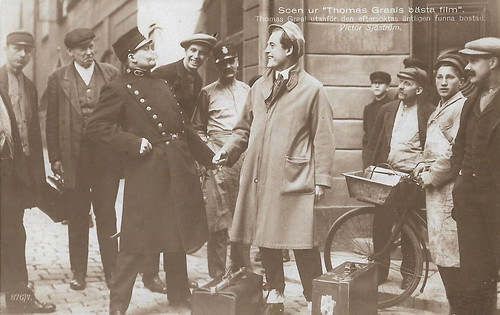
Swedish postcard by Ed. Nordisk Konst, Stockholm, no. 876/7. Photo: Svenska Biografteatern AB. Publicity still for Thomas Graals bästa film/Thomas Graal's Best Film (Mauritz Stiller, 1917), with Victor Sjöstrom. Caption: Thomas is found outside of the end-of-life home.

Swedish postcard by Ed. Nordisk Konst, Stockholm, no. 876/8. Photo: Svenska Biografteatern AB. Publicity still for Thomas Graals bästa film/Thomas Graal's Best Film (Mauritz Stiller, 1917), with Victor Sjöström and Karin Molander. Caption: The newly engaged ones.
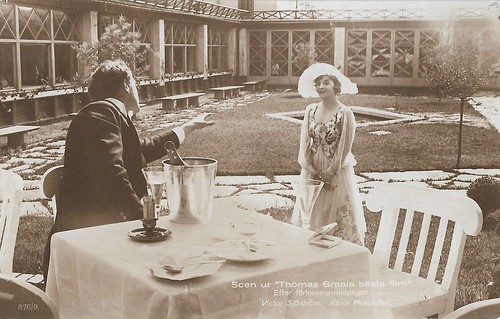
Swedish postcard by Ed. Nordisk Konst, Stockholm, no. 876/9. Photo: Svenska Biografteatern AB. Publicity still for Thomas Graals bästa film/Thomas Graal's Best Film (Mauritz Stiller, 1917), with Victor Sjöström and Karin Molander. Caption: After the engagement dinner.
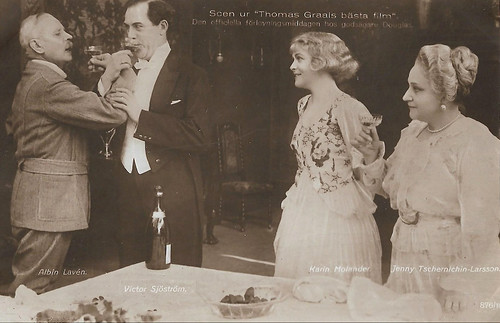
Swedish postcard by Ed. Nordisk Konst, Stockholm, no. 876/10. Photo: Svenska Biografteatern AB. Publicity still for Thomas Graals bästa film/Thomas Graal's Best Film (Mauritz Stiller, 1917). Caption: The official engagement dinner with landlord Douglas and his wife, Bessie's parents (played by Albin Lavén and Jenny Tschernichin-Larsson).
Sources: The Red Dutchess (IMDb), Wikipedia (Swedish) and IMDb.
This post was last updated onm 10 July 2022.
No comments:
Post a Comment